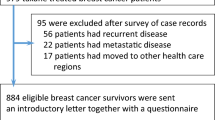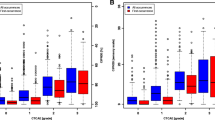Abstract
Context/objectives
This is the first study to determine the minimal clinically important difference (MCID) of the European Organisation of Research and Treatment of Cancer Quality of Life Questionnaire-CIPN twenty-item scale (EORTC QLQ-CIPN20), a validated instrument designed to elicit cancer patients’ experience of symptoms and functional limitations related to chemotherapy-induced peripheral neuropathy.
Methods
Cancer patients receiving neurotoxic chemotherapy completed EORTC QLQ-CIPN20 and the Functional Assessment of Cancer Therapy/Gynecologic Oncology Group-Neurotoxicity [FACT/GOG-NTX] at baseline, second cycle of chemotherapy (T2, n = 287), and 12 months after chemotherapy (T3, n = 191). Anchor-based approach used the validated FACT/GOG-NTX neurotoxicity (Ntx) subscale to identify optimal MCID cutoff for deterioration. Distribution-based approach used one-third standard deviation (SD), half SD, and one standard error of measurement of the total EORTC QLQ-CIPN20 score.
Results
There was a moderate correlation between the change scores of the Ntx subscale and sensory and motor subscales of QLQ-CIPN20 (T2: r = − 0.722, p < 0.001 and r = − 0.518, p < 0.001, respectively; T3: r = − 0.699; p < 0.001 and r = − 0.523, p < 0.001, respectively). The correlation between the change scores of the Ntx subscale and the QLQ-CIPN20 autonomic subscale was poor (T2: r = − 0.354, p < 0.001; T3: r = 0.286, p < 0.001). Based on the MCID derived using distribution-based method, the MCID for the QLQ-CIPN20 sensory subscale was 2.5–5.9 (6.9% to 16.4% of the subdomain score) and for motor subscale was 2.6–5.0 (8.1%–15.6% of the subdomain score).
Conclusion
The MCID for the EORTC QLQ-CIPN20 established using distribution-based approaches was 2.5–5.9 for the sensory subscale and 2.6–5.0 for the motor subscale. When noted in assessments even with small change in scores, clinicians can be alerted for appropriate intervention.
Similar content being viewed by others
References
Argyriou AA, Kyritsis AP, Makatsoris T, Kalofonos HP (2014) Chemotherapy-induced peripheral neuropathy in adults: a comprehensive update of the literature. Cancer Manag Res 6:135–147
Majithia N, Loprinzi CL, Smith TJ (2016) New practical approaches to chemotherapy-induced neuropathic pain: prevention, assessment, and treatment. Oncology (Williston Park, NY) 30:1020–1029
Miltenburg NC, Boogerd W (2014) Chemotherapy-induced neuropathy: A comprehensive survey. Cancer Treat Rev 40:872–882
Pachman DR, Watson JC, Lustberg MB, Wagner-Johnston ND, Chan A, Broadfield L, Cheung YT, Steer C, Storey DJ, Chandwani KD, Paice J, Jean-Pierre P, Oh J, Kamath J, Fallon M, Strik H, Koeppen S, Loprinzi CL (2014) Management options for established chemotherapy-induced peripheral neuropathy. Support Care Cancer 22(8):2281–95.
Matsuoka A, Mitsuma A, Maeda O, Kajiyama H, Kiyoi H, Kodera Y, Nagino M, Goto H, Ando Y (2016) Quantitative assessment of chemotherapy-induced peripheral neurotoxicity using a point-of-care nerve conduction device. Cancer Sci 107:1453–1457
Sharma S, Venkitaraman R, Vas PR, Rayman G (2015) Assessment of chemotherapy-induced peripheral neuropathy using the LDIFLARE technique: a novel technique to detect neural small fiber dysfunction. Brain and Behavior 5:e00354
Kaplow R, Iyere K (2017) Grading chemotherapy-induced peripheral neuropathy in adults. Nursing 47:67–68
McCrary JM, Goldstein D, Boyle F, Cox K, Grimison P, Kiernan MC, Krishnan AV, Lewis CR, Webber K, Baron-Hay S, Horvath L, Park SB (2017) Optimal clinical assessment strategies for chemotherapy-induced peripheral neuropathy (CIPN): a systematic review and Delphi survey. Supportive Care in Cancer : official journal of the multinational Association of Supportive Care in Cancer 25:3485–3493
Smith EML, Knoerl R, Yang JJ, Kanzawa-Lee G, Lee D, Bridges CM (2018) In Search of a Gold Standard Patient-Reported Outcome Measure for Use in Chemotherapy- Induced Peripheral Neuropathy Clinical Trials. Cancer Control : journal of the Moffitt Cancer Center 25:1073274818756608
Cavaletti G, Frigeni B, Lanzani F, Piatti M, Rota S, Briani C, Zara G, Plasmati R, Pastorelli F, Caraceni A, Pace A, Manicone M, Lissoni A, Colombo N, Bianchi G, Zanna C (2007) The Total Neuropathy Score as an assessment tool for grading the course of chemotherapy-induced peripheral neurotoxicity: comparison with the National Cancer Institute-Common Toxicity Scale. J Peripher Nerv Syst : JPNS 12:210–215
Di Maio M, Basch E, Bryce J, Perrone F (2016) Patient-reported outcomes in the evaluation of toxicity of anticancer treatments. Nat Rev Clin Oncol 13:319–325
Hausheer FH, Schilsky RL, Bain S, Berghorn EJ, Lieberman F (2006) Diagnosis, management, and evaluation of chemotherapy-induced peripheral neuropathy. Semin Oncol 33:15–49
Smith EML, Banerjee T, Yang JJ, Bridges CM, Alberti P, Sloan JA, Loprinzi C (2018) Psychometric Testing of the European Organisation for Research and Treatment of Cancer Quality of Life Questionnaire-Chemotherapy-Induced Peripheral Neuropathy 20-Item Scale Using Pooled Chemotherapy-Induced Peripheral Neuropathy Outcome Measures Standardization and Alliance for Clinical Trials in Oncology A151408 Study Data Cancer nursing
Jaeschke R, Singer J, Guyatt GH (1989) Measurement of health status . Ascertaining the minimal clinically important difference. Control Clin Trials 10:407–415
Johnston BC, Ebrahim S, Carrasco-Labra A, Furukawa TA, Patrick DL, Crawford MW, Hemmelgarn BR, Schunemann HJ, Guyatt GH, Nesrallah G (2015) Minimally important difference estimates and methods: a protocol. BMJ Open 5:e007953
Molassiotis A, Cheng HL, Lopez V, Au JSK, Chan A, Bandla A, Leung KT, Li YC, Wong KH, Suen LKP, Chan CW, Yorke J, Farrell C, Sundar R (2019) Are we mis-estimating chemotherapy-induced peripheral neuropathy? Analysis of assessment methodologies from a prospective, multinational, longitudinal cohort study of patients receiving neurotoxic chemotherapy. BMC Cancer 19:132
Calhoun EA, Welshman EE, Chang CH, Lurain JR, Fishman DA, Hunt TL, Cella D (2003) Psychometric evaluation of the Functional Assessment of Cancer Therapy/Gynecologic Oncology Group-Neurotoxicity (Fact/GOG-Ntx) questionnaire for patients receiving systemic chemotherapy. Int J Gynecol Cancer : official journal of the International Gynecological Cancer Society 13:741–748
Postma TJ, Aaronson NK, Heimans JJ, Muller MJ, Hildebrand JG, Delattre JY, Hoang-Xuan K, Lanteri-Minet M, Grant R, Huddart R, Moynihan C, Maher J, Lucey R (2005) the development of an EORTC quality of life questionnaire to assess chemotherapy-induced peripheral neuropathy: the QLQ-CIPN20. Eur J Cancer (Oxford England 1990) 41:1135–1139
Lavoie Smith EM, Barton DL, Qin R, Steen PD, Aaronson NK, Loprinzi CL (2013) Assessing patient-reported peripheral neuropathy: the reliability and validity of the European Organization for Research and Treatment of Cancer QLQ-CIPN20. Quest Qual Life Res : an international journal of quality of life aspects of treatment, care and rehabilitation 22:2787–2799
Yost KJ, Eton DT (2005) Combining distribution- and anchor-based approaches to determine minimally important differences: the FACIT experience. Eval Health Prof 28:172–191
Ogura T, Ackermann J, Barbieri Mestriner A, Merkely G, Gomoll AH (2018) Minimal Clinically Important Differences and Substantial Clinical Benefit in Patient-Reported Outcome Measures after Autologous Chondrocyte Implantation. Cartilage 15:1947603518799839
Revicki D, Hays RD, Cella D, Sloan J (2008) Recommended methods for determining responsiveness and minimally important differences for patient-reported outcomes. J Clin Epidemiol 61:102–109
Huang HQ, Brady MF, Cella D, Fleming G (2007) Validation and reduction of FACT/GOG-Ntx subscale for platinum/paclitaxel-induced neurologic symptoms: a gynecologic oncology group study international journal of gynecological cancer : official journal of the international gynecological. Cancer Soc 17:387–393
Husted JA, Cook RJ, Farewell VT, Gladman DD (2000) Methods for assessing responsiveness: a critical review and recommendations. J Clin Epidemiol 53:459–468
Cella D, Eton DT, Lai JS, Peterman AH, Merkel DE (2002) Combining anchor and distribution-based methods to derive minimal clinically important differences on the Functional Assessment of Cancer Therapy (FACT) anemia and fatigue scales. J Pain Symptom Manag 24:547–561
Maringwa J, Quinten C, King M, Ringash J, Osoba D, Coens C, Martinelli F, Reeve BB, Gotay C, Greimel E, Flechtner H, Cleeland CS, Schmucker-Von Koch J, Weis J, Van Den Bent MJ, Stupp R, Taphoorn MJ, Bottomley A (2011) Minimal clinically meaningful differences for the EORTC QLQ-C30 and EORTC QLQ-BN20 scales in brain cancer patients annals of oncology : official journal of the European society for. Med Oncol 22:2107–2112
Wyrwich KW, Tierney WM, Wolinsky FD (1999) Further evidence supporting an SEM-based criterion for identifying meaningful intra-individual changes in health-related quality of life. J Clin Epidemiol 52:861–873
Cavaletti G, Cornblath DR, Merkies IS, Postma TJ, Rossi E, Frigeni B, Alberti P, Bruna J, Velasco R, Argyriou AA, Kalofonos HP, Psimaras D, Ricard D, Pace A, Galie E, Briani C, Dalla Torre C, Faber CG, Lalisang RI, Boogerd W, Brandsma D, Koeppen S, Hense J, Storey D, Kerrigan S, Schenone A, Fabbri S, Valsecchi MG (2013) The chemotherapy-induced peripheral neuropathy outcome measures standardization study: from consensus to the first validity and reliability findings. Ann Oncol : official journal of the European Society for Medical Oncology 24:454–462
Hays RD, Woolley JM (2000) The concept of clinically meaningful difference in health-related quality-of-life research. How meaningful is it? PharmacoEconomics 18:419–423
Starobova H, Vetter I (2017) Pathophysiology of Chemotherapy-Induced Peripheral Neuropathy. Front Mol Neurosci 10:174
Addington J, Freimer M (2016) Chemotherapy-induced peripheral neuropathy: an update on the current understanding F1000Research 5
Ringash J, O'Sullivan B, Bezjak A, Redelmeier DA (2007) Interpreting clinically significant changes in patient-reported outcomes. Cancer 110:196–202
Holmes MM, Lewith G, Newell D, Field J, Bishop FL (2017) The impact of patient-reported outcome measures in clinical practice for pain: a systematic review. Qual Life Res Int J Qual Life Asp Treat Care Rehab 26:245–257
Dobrozsi S, Panepinto J (2015) Patient-reported outcomes in clinical practice. Hematol Am Soc Hematol Educ Program 2015:501–506
NIH (2018) Peripheral Neuropathy Fact Sheet. Available at https://www.ninds.nih.gov/Disorders/Patient-Caregiver-Education/Fact-Sheets/Peripheral-Neuropathy-Fact-Sheet [Assessed 1 July 2018]
Chan A, Yo TE, Wang XJ, Ng T, Chae JW, Yeo HL, Shwe M, Gan YX (2018) Minimal Clinically Important Difference of the Multidimensional Fatigue Symptom Inventory-Short Form (MFSI-SF) for Fatigue Worsening in Asian Breast Cancer Patients. J Pain Symptom Manag 55:992–997.e992
Cheung YT, Foo YL, Shwe M, Tan YP, Fan G, Yong WS, Madhukumar P, Ooi WS, Chay WY, Dent RA, Ang SF, Lo SK, Yap YS, Ng R, Chan A (2014) Minimal clinically important difference (MCID) for the functional assessment of cancer therapy: cognitive function (FACT-Cog) in breast cancer patients. J Clin Epidemiol 67:811–820
Smith EML, Zanville N, Kanzawa-Lee G, Donohoe C, Bridges C, Loprinzi C, Le-Rademacher J, Yang JJ (2018) Rasch model-based testing of the European Organisation for Research and Treatment of Cancer (EORTC) Quality of Life Questionnaire-Chemotherapy-Induced Peripheral Neuropathy (QLQ-CIPN20) using Alliance for Clinical Trials in Oncology (Alliance) A151408 study data. Support Care Cancer : official journal of the Multinational Association of Supportive Care in Cancer
Acknowledgements
The authors would like to thank the participants for their contribution to this study.
Author information
Authors and Affiliations
Corresponding authors
Ethics declarations
Conflict of interest
The authors declare that they have no conflict of interest.
Declaration
Herewith I state to have full control of all primary data and that I agree to allow the journal to review our data if requested.
Ethics statement
The study was approved by the institutional review boards of each participating institution (National University Health System, Singapore; Queen Elizabeth Hospital, Hong Kong; University of Manchester, UK). All procedures performed in studies involving human participants were in accordance with the ethical standards of the institutional and/or national research committee and with the 1964 Helsinki declaration and its later amendments or comparable ethical standards.
Informed consent
Informed consent was obtained from all individual participants included in the study.
Additional information
Publisher’s note
Springer Nature remains neutral with regard to jurisdictional claims in published maps and institutional affiliations.
Rights and permissions
About this article
Cite this article
Yeo, F., Ng, C.C., Loh, K.W.J. et al. Minimal clinically important difference of the EORTC QLQ-CIPN20 for worsening peripheral neuropathy in patients receiving neurotoxic chemotherapy. Support Care Cancer 27, 4753–4762 (2019). https://doi.org/10.1007/s00520-019-04771-8
Received:
Accepted:
Published:
Issue Date:
DOI: https://doi.org/10.1007/s00520-019-04771-8




